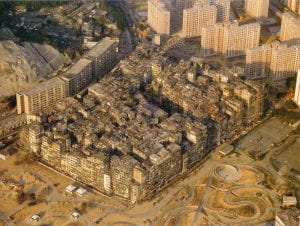Urban slums are characterized by overcrowding, lack of access to essential services, substandard housing, and unsanitary conditions. According to the United Nations (2021), more than 1 billion people – every one out of four urban residents – live in slums or informal settlements; the world’s slum dwellers are primarily in three regions: Eastern and South-Eastern Asia, Sub-Saharan Africa, and Central and Southern Asia. One of the biggest challenges to city governments in these regions during the urbanization process is dealing with such urban slums and addressing the needs of slum dwellers. One approach adopted by certain city governments is slum clearance. The demolition of Kowloon Walled City in Hong Kong is just such a case.
Kowloon Walled City (KWC) was an ungoverned informal settlement in Hong Kong. In 1898, the Convention for the Extension of Hong Kong Territory signed between the Qing Dynasty (the Chinese Government back then) and the United Kingdom signified the lease of the “New Territories” in Hong Kong to the United Kingdom for 99 years rent-free. Notably, the KWC, located within the boundary of the “New Territories,” was exempt from the Convention and thus still under the control of the Qing Dynasty. Nevertheless, while China legally held the sovereignty and administrative power in KWC, China didn’t exercise them in the next few decades after 1898. Meanwhile, Britain claimed that it had administrative power over KWC but never executed it. These made KWC a place that lacked law enforcement.
The population in KWC increased dramatically following WWII, from 2,000 plus inhabitants in 1947 to around 33,000 in 1987 (Ho, 2018). In the late 1980s, KWC was the densest place on earth – a population density of 1.25 million persons per square kilometer. This mega-slum had around 500 buildings of 10-14 stories (see picture below). KWC residents were not required to pay property tax. And business operators and industries inside the KWC were not required to register with the British Hong Kong Government. As a result, people who failed to obtain recognized qualifications, e.g., medical practitioners and unlicensed dentists, those whose work involved illicit industries, and those who couldn’t afford high rent, chose to live in KWC.
Figure 1. Kowloon Walled City Aerial Photo

Source: Ian Lambot (1989). An aerial photo of the Kowloon Walled City.
Several times in history, the British Hong Kong Government wanted to eliminate KWC but failed to do so due to the opposition of the KWC residents and political concerns, such as the diplomatic pressure first from Kuomintang and then later from the Chinese communists (the political party in power at different times). Only in the early 1980s, when the bilateral relationship between Britain and China had improved and Hong Kong’s return to China in 1997 had been set on the agenda, did the British Hong Kong Government touch on the thorny issue of KWC and announce its decision to tear down KWC in January 1987. The Hong Kong Housing Authority organized four waves of rehousing efforts from November 1987 to July 1992 (see graph below). After rehousing the dislocated population, KWC was demolished from March 1993 to April 1994. And a historical park was built on-site from May 1994 to Dec. 1995.
Figure 2. Four Waves of Rehousing Efforts

Note: This graph was created by the author based on a government report by Hong Kong Housing Authority (2002)
Thirty years after KWC’s demolition, several questions regarding this urban slum clearance action are still pending: whether slum clearance is the best policy option to deal with mega-slums? Whether those rehoused slum dwellers and their offspring have better access to education and job opportunities? Are the overall welfare effects of such slum clearance action in the long run positive? On the one hand, the KWC could be seen as highly disadvantaged compared to other nearby neighborhoods, given the high crime rate and unsanitary conditions. On the other hand, the KWC also served a useful purpose for the city, given that it provided access to medical services and various products at a relatively lower price for the city residents. Scholars from George Washington University are currently analyzing the effects of this slum clearance action on the short-term and long-term socio-economic outcomes in the hope of providing better policy recommendations for developing countries experiencing rapid urbanization.
References:
Girard, Greg and Ian Lambot. 1993. City of Darkness: Life in Kowloon Walled City. Watermark Publications (UK) Ltd.
Ho, Pui-yin. 2018. Making Hong Kong: a history of its urban development. Cheltenham, UK: Edward Elgar Publishing.
Hong Kong Housing Authority. 2002. Report on the Work of the Special Committee on Clearance of Kowloon Walled City.
United Nations. 2021. “Urban Population Living in Slums or Informal Settlements, 2018.” https://unstats.un.org/sdgs/report/2021/goal-11/ (Accessed May 9, 2022).
By Jingwen Zhen, Sigur Center Summer Grant for Asian Field Research Awardee.
Any errors in the blog are the author’s.
